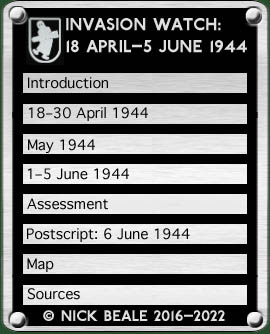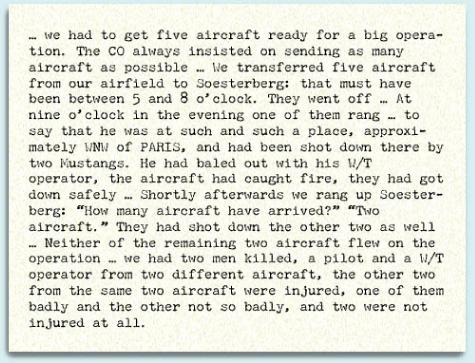|
On 18 April for the first time in more than six months, s/e fighter recce a/c operated over the Straits and Estuary … ZIP/NA 447 (Air Operational Watch, Bletchley Park) In British eyes this marked the start of anti-invasion reconnaissance. Before then the Germans had apparently confined themselves to security reconnaissance, maintaining an irregular watch over the seas between between Britain and France but not venturing over land. Peter Lucas of Bletchley Park’s Hut 3 Operational Watch was able to note by 7 May how: It has been repeatedly stated in various sources by the Germans that prior to the beginning of this recce they had no knowledge from air recce of where the invasion concentrations are. Lucas was contradicted in late August by the interrogation report of 5.(F)/123’s Ltn. Walter Warthol: In February and March 5.(F)/123 carried out photographic reconnaissances of the harbours at Portsmouth, Southampton and Poole and also over the Isle of Wight. Photographs were taken with 30% overlap from heights of about 12,000 metres, and were extremely clear. On all these flights GM 1 was used. Evidently, Warthol set these dates too early or why would the Germans have been comparing their April 1944 results to ones from August and September 1943 (see below)? What is more Warthol’s Staffel normally operated further east, 4.(F)/123 covering the targets in question. However, the Kriegsmarine (see above) was assessing the results of such sorties in February. The Ju 188s of 3.(F)/122 meanwhile were watching the North Sea off Holland but had: … not approached the East Coast since last Autumn; [they] might for some special reason be drawn on to approach on an isolated occasion the coast of East Anglia again, but could not operate regularly in this area because of fighter defence. Considering all this inactivity, Bletchley Park thought it significant that on 2 April, 5.(F)/123 had only three pilots ready for operations and seven detached. It was thought possible that the latter were attending a training course. By the 13th, six men were ready and five not but no detachments were reported. The dispatches of the Japanese Naval Attaché in Berlin were being intercepted and read by the Allies and on 13 April, before the German photographic effort had got under way, he reported: Air reconnaissance shows concentration in Southern England begun and troops concentrating at night. Luftwaffe units reported their strength and 10-day intervals and the 10 April figures for the single-seater reconnaissance force on the Channel were:
From an Allied intelligence appreciation of German knowledge of the invasion plans: On the same day [17 April 1944] Admiral Doenitz issued a proclamation to all ranks on the imminence of the allied invasion of Western Europe … On 18/4 for the first time for six months, S.E. [single-engined] fighter recce aircraft operated over the invasion ports. On 18/4, for the first time for six months, S.E. fighter recce aircraft operated over the invasion ports. 18 April Late in the afternoon a German aircraft (probably of 5.(F)/123, since this was their sector — see map — sighted 50 ships stationary off Sheerness and others in the Dover Straits. Remarkably, this was the first reconnaissance of the area since September 1943. Coverage was achieved of Chatham, Tilbury, Gravesend, Dagenham, Purfleet and Woolwich. Warships seen mostly lay in Chatham, there were 39 steamers totalling 135,000 GRT and (largely in Tilbury) 40 “landing boats”. The small vessels at Ramsgate and Sandwich were nothing out of the ordinary and there were no obvious signs of invasion preparations, just of busy Thames traffic. According to the Japanese Naval Attaché: “recce of Thames shows nothing fresh”. 19 April Attempt at aerial reconnaissance of the southeast coast of England must be broken off on technical grounds. Photo-reconnaissance of Portsmouth failed because picture cannot be interpreted. Seekriegsleitung diary Between 11.06 and 11.43 British defences plotted an enemy aircraft flying off the coast near Portsmouth and Selsey Bill and over the eastern side of the Isle of Wight before returning toward Cherbourg. Although this was first attributed to NAG 13 but a pencilled note on the Operational Watch report warns: “Yvonne says R/T is available but the unit can’t be NAG 13” and this was on 4.(F)/123’s normal patch. At 1750, radio traffic suggested that a cross-Channel reconnaissance was underway, the aircraft being warned of British fighters near Bognor Regis. The flight, which was not picked up on radar, but was controlled from Caen and the plane landed “in the Triqueville area”, perhaps Conches-en-Ouche or Saint-André-de-l’Eure. A little later, German naval authorities were advised of three minesweepers in line astern, heading ENE in the Dover Straits, the British surmising that this may have been a sighting by 5.(F)/123. 20 April At 14.04 GMT, two aircraft of NAG 13 left Dinard on a course which would have taken them over the Brixham – Dartmouth area but the British Home Security Intelligence Summary for the day noted that “no enemy aircraft has crossed the coast”. The day brought a blow to 1.(F)/121 when three of its Me 410s were shot down while deploying from Buc to Soesterberg, whence they were to accompany a raid on Hull. The Staffel’s Ofhr. Werner Meyer recalled what happened:
All three of the Me 410s (W.Nr. 170009, 170031 and 170088) had burned out after hitting the ground. The first of these machines had carried a FuG 216 tail-warning radar. continued on next page …
|
|||||||||||||||||||||||||||||||||


